Etude de bruit de fond induit par les muons dans l'expérience ...
Etude de bruit de fond induit par les muons dans l'expérience ...
Etude de bruit de fond induit par les muons dans l'expérience ...
You also want an ePaper? Increase the reach of your titles
YUMPU automatically turns print PDFs into web optimized ePapers that Google loves.
tel-00724955, version 1 - 23 Aug 2012<br />
2.3 Direct <strong>de</strong>tection 45<br />
the DAMA/NaI which accumulated an exposure of 0.29 ton-year, are also shown.<br />
The improved signal due to increased statistics is clear in this plot and an annual<br />
modulation is evi<strong>de</strong>nt. Other possible systematic effects such as temperature effects<br />
on the noise of the photomultiplier tubes, humidity related backgrounds, radon or<br />
other systematic effects has not been conclusively established.<br />
Assuming a spin-in<strong>de</strong>pen<strong>de</strong>nt interaction and a WIMP mass of tens of GeV/c 2<br />
or higher, the WIMP-nucleus cross section extracted from the annual modulation<br />
in the DAMA/NaI experiment would correspond to ∼ 10 −5 pb. This claim has<br />
been ruled out by previous CDMS experiment results [123] and by many other<br />
experiments, including various targets and radically different techniques, such as<br />
the XENON 10 experiment [116]. Neverthe<strong>les</strong>s, due to the insufficiently-low energy<br />
threshold of the majority of the other experiments, it has been proposed that light<br />
WIMPs (∼ 10 GeV/c 2 ) could cause the observed modulation and still be un<strong>de</strong>tected<br />
by the other experiments [128, 129]. Recently, the COUPP collaboration, using<br />
an improved bubble chamber technology, has ruled out the WIMP hypothesis for<br />
spin-<strong>de</strong>pen<strong>de</strong>nt WIMP-nucleus interactions [130]. The remaining possibility that<br />
low-mass WIMPs un<strong>de</strong>rgo spin-in<strong>de</strong>pen<strong>de</strong>nt interactions has been ruled out more<br />
recently by the CoGeNT collaboration [131] employing a new type of Germanium<br />
radiation <strong>de</strong>tector with a very low electronic noise [132]. And finally a latest attempt<br />
to reconcile the <strong>de</strong>tection of annual modulation observation of DAMA experiment<br />
and null results from all other experiments was to introduce inelastic dark matter.<br />
Inelastic dark matter mo<strong>de</strong>l explored the possibility of an altered kinematics of the<br />
collision between the χ and the nuclei. This scenario seems to be also ruled out by<br />
the noble liquid Xenon <strong>de</strong>tector of the ZEPLIN-II experiment [133].<br />
The DAMA results have not been solved yet. The collaboration has not been<br />
able to i<strong>de</strong>ntify any other systematic effects capable of producing this signal. However,<br />
the claim that this signal is the result of dark matter interactions is in direct<br />
conflict with any other experiments. The DAMA results may be an artificial, one<br />
dare say a false, result or may lead to a non-MSSM dark matter candidate, as long<br />
as the results are not reproduced, the claim is not conclusive.<br />
Direct <strong>de</strong>tection of dark matter encompasses all those experiments that search for<br />
a dark matter <strong>par</strong>ticle interacting directly with the <strong>de</strong>tector, via elastic scattering,<br />
for example, with a target nucleus causing a nuclear recoil of about 15 keV. Indirect<br />
<strong>de</strong>tection experiments search for a non-WIMP <strong>par</strong>ticle originating from WIMPs that<br />
interact with the <strong>de</strong>tector. In colli<strong>de</strong>r experiments a new <strong>par</strong>ticle may be produced<br />
and be <strong>de</strong>tectable in a twist of looking for “missing energy” or missing transfer<br />
momentum.<br />
However, a measurement of the couplings is highly unlikely in colli<strong>de</strong>r, and it<br />
will not be possible to <strong>de</strong>termine if the “missing <strong>par</strong>ticle” has the necessary stability<br />
to be a “freeze out” product from the Big-Bang. Moreover, the production rate and<br />
<strong>de</strong>tectability of WIMPs at colli<strong>de</strong>rs <strong>de</strong>pends primarily upon the masses of the WIMP<br />
and related new <strong>par</strong>tic<strong>les</strong>: If the <strong>par</strong>tic<strong>les</strong> are too heavy, they cannot be produced.<br />
Thus, primary annihilation processes that set the relic <strong>de</strong>nsity in some WIMP mo<strong>de</strong>ls<br />
are temperature-<strong>de</strong>pen<strong>de</strong>nt. The annihilation rates of such mo<strong>de</strong>ls are greatly<br />
2


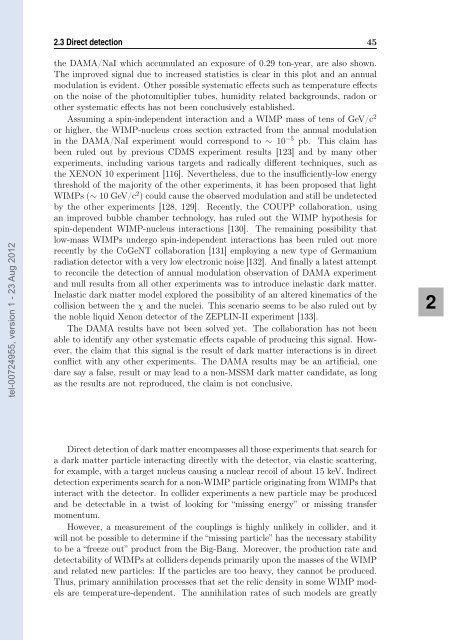

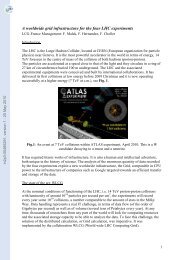

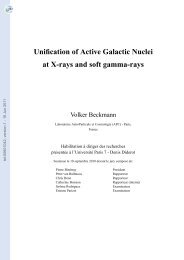

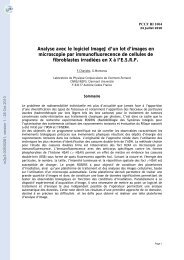
![[in2p3-00383985, v1] NUCLEAR PHYSICS at GANIL ... - HAL - IN2P3](https://img.yumpu.com/19016755/1/185x260/in2p3-00383985-v1-nuclear-physics-at-ganil-hal-in2p3.jpg?quality=85)
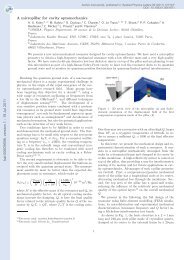
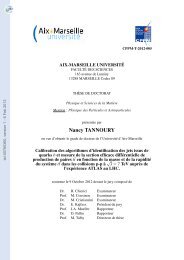
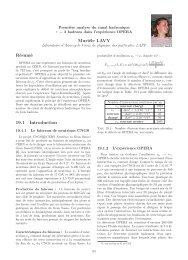
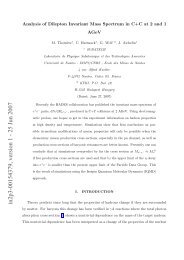
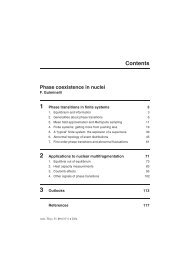
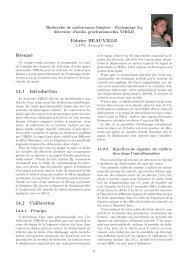
![[tel-00752304, v1] Pions réels et virtuels dans les noyaux](https://img.yumpu.com/19016523/1/184x260/tel-00752304-v1-pions-reels-et-virtuels-dans-les-noyaux.jpg?quality=85)